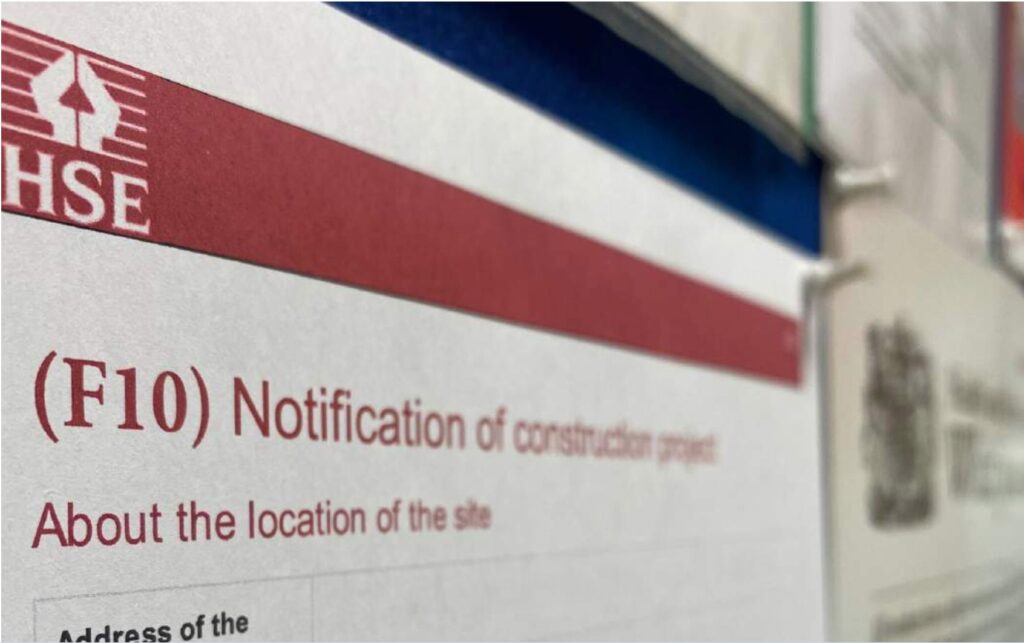Credit: Pro Safety Management The F10 is a legal notification form that must be submitted to the Health and Safety Executive (HSE) for certain construction projects in the UK. It provides details of the project to the HSE before work begins on-site. An F10 is required for construction projects that are expected to last longer than 30 working days and have 20 or more workers on-site at any one time. Completing and submitting the F10 form is a legal duty for notifiable projects under the Construction Design and Management regulations. In our experience, the F10 is an important part of managing health and safety on major construction projects. It aids the HSE in identifying sites where additional inspection and enforcement may be necessary. We always advise clients to carefully check if their upcoming project requires an F10 submission and to complete the form accurately and on time. The F10 sets the tone for HSE engagement throughout the project lifecycle. The F10 form is a notification to the Health and Safety Executive (HSE) of relevant construction projects taking place within a specific time and location. Medium to large-scale projects expected to last over 30 working days and involve 20 or more workers must complete this form. The F10 provides key details about the construction project to the HSE, including: Submitting the F10 form is a legal requirement under UK health and safety regulations. It allows the HSE and local authorities to be aware of major construction projects happening in their jurisdiction. Some key points on the F10 form: In summary, the F10 form provides vital information to the authorities on upcoming medium to large construction projects. It is a key part of complying with health and safety regulations in the UK construction industry. Credit: CHAS Knowing when to submit the F10 form is crucial. If you are the CDM coordinator for a construction project, you must notify the HSE of the project details before work starts on site. Submit the F10 as early as possible once you complete initial planning and confirm the project details. Many CDM coordinators recommend submitting the form at least 28 days before the scheduled start of work. You should not wait until just before or after construction starts to send the F10. Submitting it late leaves insufficient time for the HSE to prepare and means you are failing to comply with the law. To recap the key timing requirements: You may need to send an updated F10 if the project details change substantially after initially submitting the form. But you must get the first notification to the HSE in good time before work starts. In summary, early submission of the F10 is vital for remaining compliant with health and safety laws. As the CDM coordinator, this responsibility falls on you. Completing the F10 form correctly is essential to notify the HSE with accurate project details. The form asks for specific information that must be provided. Start by including the project address and expected duration. Give the exact street address and postcode where construction will take place. For duration, specify the number of weeks or months the project is scheduled to last. Next, provide details on the client, principal designer, principal contractor, and CDM coordinator. Give the full business name and contact information for each. The client is the organisation for whom the work is being carried out. You’ll also need to describe the project work and key dates. Outline the main scope activities in simple terms. And list the planned start and end dates. Finally, specify the number of people expected to be working on site. This helps the HSE understand the scale and plan accordingly. Before submitting, double-check check all details provided are accurate. Any errors could delay approval. Also, be sure to keep a copy for your records. With the proper information included, the HSE can process the F10 efficiently. Taking time to complete it fully pays off by ensuring swift and straightforward approval. When you fill out the F10 form, following the guidelines helps ensure you complete it properly. Being aware of the requirements can prevent delays in approval. If your project involves high-risk activities like deep excavation, ensure workers involved in such tasks undergo proper deep excavation training. One key guideline is to provide the exact construction site address. Include the full postcode so the location can be precisely identified. Abbreviations or partial addresses often lead to confusion. All parts of the form must be filled out. Blank sections or missing details will hold up processing. Even if certain fields seem redundant, they should still be completed. Use the specified format for dates and contact information. Entering phone numbers or dates incorrectly can make details hard to decipher. The form must be submitted in advance of the project start date. Allow sufficient time for the HSE to review and approve based on their processing timeline. Only a project that will last more than 30 days requires an F10 form. Shorter-duration work may be exempt. Check the regulations to confirm. Print clearly in black ink if submitting a paper form. Illegible handwriting slows things down. The online form ensures legibility. Following these guidelines carefully shows attention to detail. Adhering to the requirements helps the F10 form get processed smoothly. Failing to submit an F10 form when required can lead to significant consequences. Being aware of the risks helps ensure you follow the proper process. Starting work without an approved F10 means the project is not compliant with safety regulations. This exposes all involved parties to potential litigation if an incident occurs. The client can withhold payment or terminate the contract if work begins without the proper notifications filed. This causes major financial and legal headaches. Inspectors can halt construction upon discovering a missing F10 submission. Delays from work stoppages can cost thousands in lost productivity and missed deadlines. Fines of up to £3,000 per day can be levied if a valid F10 is not on file for the project duration. These penalties quickly add up and eat into profits. Cutting corners on safety compliance can damage your reputation and eligibility for future work. Few clients will risk hiring a contractor with a track record of violations. Don’t let forgetting a form put your project and business at risk. Following proper F10 protocols demonstrates your professionalism and commitment to safety. An F10 should be submitted to the HSE before any construction work covered by the regulations commences on site. The notice must be given to the HSE at least 14 days before work starts. Yes, submitting an F10 is a legal requirement under the Construction (Design and Management) Regulations for notifiable projects. Failure to submit a form is a criminal offence. The F10 calculation refers to determining if a construction project meets the criteria for being legally notifiable to the HSE. This involves estimating if the work will last more than 30 days and involve 20 or more workers simultaneously at any point during the project. Display a clear copy of the F10 submission in the construction site office. It is also good practice to display a copy in a public area of the site such as near the entrance. Contractors must notify the authorities of construction projects if the work is expected to meet specific criteria. To notify the Health and Safety Executive (HSE) about a construction project, you need to complete an online form called the F10. This form is a notification to the HSE of relevant construction projects taking place within a specific time and location. The F10 notification is required for medium/large scale projects that are expected to last for more than 30 working days and involve 20 or more people. The form includes information such as the date of forwarding the notice, the address or precise description of the construction site, and other project details. It is important to note that construction work for a domestic client does not require notification. The F10 form should be used by the CDM co-ordinator for the project or the F10 Scanning Centre.
What Is an F10 in Construction?

Key Points
Our Opinion
What Is an F10 Form?
When to Submit an F10 Form

How to Complete the F10 Form
Ensuring Compliance and Efficiency
Consequences of Non-Compliance with F10 Requirements
FAQ
When should an F10 be submitted?
Is an F10 a legal requirement?
What is the F10 calculation?
Where should an F10 be displayed?
Conclusion
